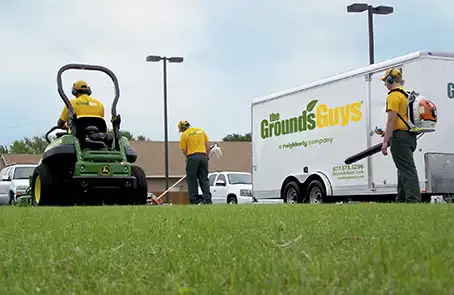Commonly referred to as core aeration, this vital practice involves the use of a specialized lawn aerator to perforate the soil with small holes. These perforations facilitate the penetration of air and water to the grassroots, enhancing soil drainage and fostering essential microorganisms, including microflora, microfauna, and worms, which thrive on oxygen. By aerating your lawn annually, you promote robust grass growth and unlock numerous benefits that contribute to the vitality and aesthetics of your lawn.
Understanding the Benefits of Aerating Your Lawn
Before dismissing the idea of incorporating lawn aeration into your routine, it's crucial to grasp the myriad benefits it brings:
- Promotes robust root development for healthier, resilient grass.
- Enhances soil health by allowing water, air, and nutrients to reach deep into the roots.
- Alleviates soil compaction, improving drainage and root growth.
- Facilitates better fertilization for lush, green growth.
- Prevents mushroom growth by reducing thatch buildup and moisture retention.
- Enhances insect resistance for a pest-free lawn.
- Improves drought resistance by developing deep, water-accessible roots.
- Stimulates new growth for denser turf.
- Reduces maintenance needs by promoting healthy grass growth.
Considering these numerous benefits, lawn aeration can significantly improve the health, appearance, and resilience of your lawn, making it a worthwhile investment in your landscape's long-term vitality.
Knowing When to Aerate Your Lawn
Timing your lawn aeration depends on the grass type. For cool-season grass, opt for spring and fall aeration. Warm-season grass thrives with aeration from spring to summer. Aerating when the grass is active and growing ensures a healthy, green lawn.
You know it's time for aeration when water pools instead of seeping in, soil compacts, or grass looks lackluster. Thin spots may require extra care, but aerating helps overall.
Consider professional lawn aeration if you notice:
- Dry, compacted soil that resists penetration.
- Bare patches where no grass or weeds grow due to soil compaction.
- Poor drainage causes puddles after rain or irrigation.
- Thatch accumulation exceeding 1 cm.
- Heavy traffic areas show signs of compaction from equipment or foot traffic.
If you see these signs, consider professional aeration services to restore your lawn's health and vibrancy.
Determining the Ideal Frequency for Lawn Aeration
For optimal lawn health, we recommend aerating your lawn annually. However, if your lawn faces heavy foot traffic leading to grass and soil wear, consider aerating more frequently during spring or fall yard cleanup.
Cost of Aeration
Determining the cost of lawn aeration involves considering various factors, with the size of your yard being the most influential. Smaller yards naturally incur lower costs compared to larger ones, while obstacles or challenging-to-reach areas may also impact pricing.
If you're contemplating a DIY approach to lawn aeration, it's essential to factor in the cost of renting or purchasing a mechanical aerator. Quality machines capable of delivering precise results come with a significant price tag.
Opting for professional lawn aeration services from The Grounds Guys of New Albany proves advantageous. We boast top-tier, professional-grade equipment designed for optimal results, coupled with the expertise to operate it effectively.
DIY Aeration Considerations
While some homeowners opt for the do-it-yourself route, it's crucial to weigh the pros and cons carefully. While you may save a bit of money if you already own suitable lawn aerator equipment, a lack of experience could lead to inadequate aeration, failing to penetrate deep into the soil. This shallow aeration may restrict the flow of air, nutrients, and water essential for nurturing healthy grass.
Navigating the intricacies of lawn aeration involves numerous tips, techniques, and potential pitfalls to consider before, during, and after the process. For comprehensive guidance, we recommend consulting with a landscaping professional. They can provide invaluable insights and ensure that you're equipped with all the necessary information to achieve optimal results for your lawn.
Essential Steps for Preparing Your Lawn for Aeration
If you're planning to aerate your lawn yourself, it's essential to prepare properly. Here are some helpful tips to ensure successful lawn aeration:
- Check Soil Moisture - Avoid aerating when the soil is excessively wet or dry. The ideal soil condition is slightly moist but not sodden. If the soil is too dry, consider watering it lightly before aeration to achieve the optimal moisture level.
- Timing - Aerate before applying any fertilizers to your lawn. This allows for better penetration of nutrients into the soil and enhances their effectiveness.
- Mowing - It's advisable to mow your lawn before aeration. Trimming the grass to a moderate height ensures better access for aeration tools and allows for more efficient aeration.
- Note Lawn Fixtures - Before you begin, identify and mark any lawn fixtures such as sprinklers or irrigation lines to avoid damaging them during aeration.
- Soil Moisture Check - Ensure that the soil is sufficiently damp for aeration. If the ground is too dry, consider watering the lawn a day or two before aeration to achieve the desired moisture level.
Exploring the Different Types of Lawn Aeration Equipment
Choosing the right aeration tool is crucial for effective lawn aeration. Here are two common types of aeration tools and their respective methods:
- Spike Aerators - These tools puncture the soil, creating holes to improve ventilation. Spike aerators do not remove soil cores from the ground. Options include garden forks, rolling aerators, or spiked lawn shoes.
- Core or Plug Aerators - These tools remove soil cores from the ground, perforating the grass and soil. Manual core aerators, walk-behind aerators, or tow plug aerators are suitable options for this method.
Deciding between handheld and machine-powered lawn aerators depends on your needs and preferences. Machine aerators are efficient for large areas, while handheld tools are better for small or hard-to-reach spots. Consider your lawn's size, terrain, and accessibility to choose the best aerator type for you.
After Aeration Care
To maximize the benefits of lawn aeration, follow these post-aeration practices:
- Leave Soil Cores - Leave the soil cores on the lawn to decompose naturally and reintegrate into the soil, enriching it with organic matter.
- Water and Fertilize - Water the lawn thoroughly after aeration to promote recovery and nutrient absorption. Additionally, apply fertilizer to nourish the grass and support healthy growth.
- Overseeding - If your lawn has thin or bare patches, consider overseeding after aeration to promote new grass growth and fill in sparse areas.
By following these guidelines, you can ensure a successful lawn aeration process and enjoy a healthier, greener lawn.
Revitalize Your Lawn with Our Exceptional Aeration Services
Don't let the hassle of lawn aeration overwhelm you. Trust The Grounds Guys of New Albany for top-notch services using advanced techniques and equipment, ensuring a lush and healthy lawn.
After aeration, maintain your lawn with ease. We understand the demands on your schedule and are here to help. As a Neighborly™ company, we guarantee satisfaction through our Neighborly Done Right Promise™.
Contact us today to discover more about our aeration services and comprehensive landscaping solutions.
 Click to call
Click to call
 Click to call
Click to call








